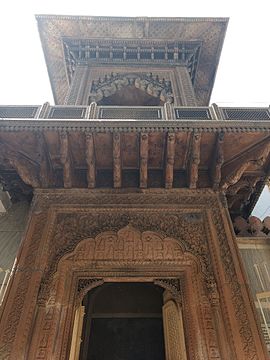Naya Mandir
| Naya Mandir | |
|---|---|

Naya Mandir, Dharampura, Delhi.
|
|
| Basic information | |
| Location | Dharampura, Delhi, India |
| Geographic coordinates | 28°39′10.0″N 77°13′54.4″E / 28.652778°N 77.231778°ECoordinates: 28°39′10.0″N 77°13′54.4″E / 28.652778°N 77.231778°E |
| Affiliation | Jainism |
| Festivals | Mahavir Jayanti |
| Architectural description | |
| Creator | Raja Harsukh Rai |
| Date established | 1807 |
| Temple(s) | 1 |
Naya Mandir (नया मंदिर literally new temple) is a historic Jain temple in Old Delhi, in the Dharampura locality allocated to the Jain community by Aurangzeb.
Raja Harsukh Rai, imperial treasurer in the late Mughal period, constructed a large and ornate Jain temple in the Dharampura locality of Old Delhi in 1807 during the rule of Mughal Emperor Akbar II with a cost of about 8 Lakh rupees, then an enormous amount. He was able to obtain the royal permission to construct a shikhara for the temple for the first time during the Mughal rule. Thus temple is known as the Naya Mandir (new temple), since an older Jain temple, now known as the Lal Mandir already existed.
When the temple construction was almost finished, Harsukh Rai stopped the construction. When the representatives of the Agrawal Jain community approached him and asked about it, he claimed that he has run out of money and needed donations from the community to finish the construction. After accepting modest donations, Harsukh Rai declared the temple to be panchayati (i.e. belonging to the community, rather than himself) and finished the construction.
During the festivities of temple consecration (Panch-kalyanak Pratishtha), the festive pandal was raided by a local group and the gold and silver objects (chhatra, chamar, utensils) were plundered. Harsukh Rai complained to the Emperor, who ordered that they be returned.
The temple houses an important collection of manuscripts.
The Naya Mandir book collection includes a rare illustrated manuscript of Maha-purana of Acharya Jinasena. This manuscript dated to 1420 CE is a rare surviving example of Jain (and Indian) art in early 15th century.
After the 1857 Ghadar and during early 20th century, this was the temple referred to as the Jain temple of Delhi by several European visitors.
...
Wikipedia

